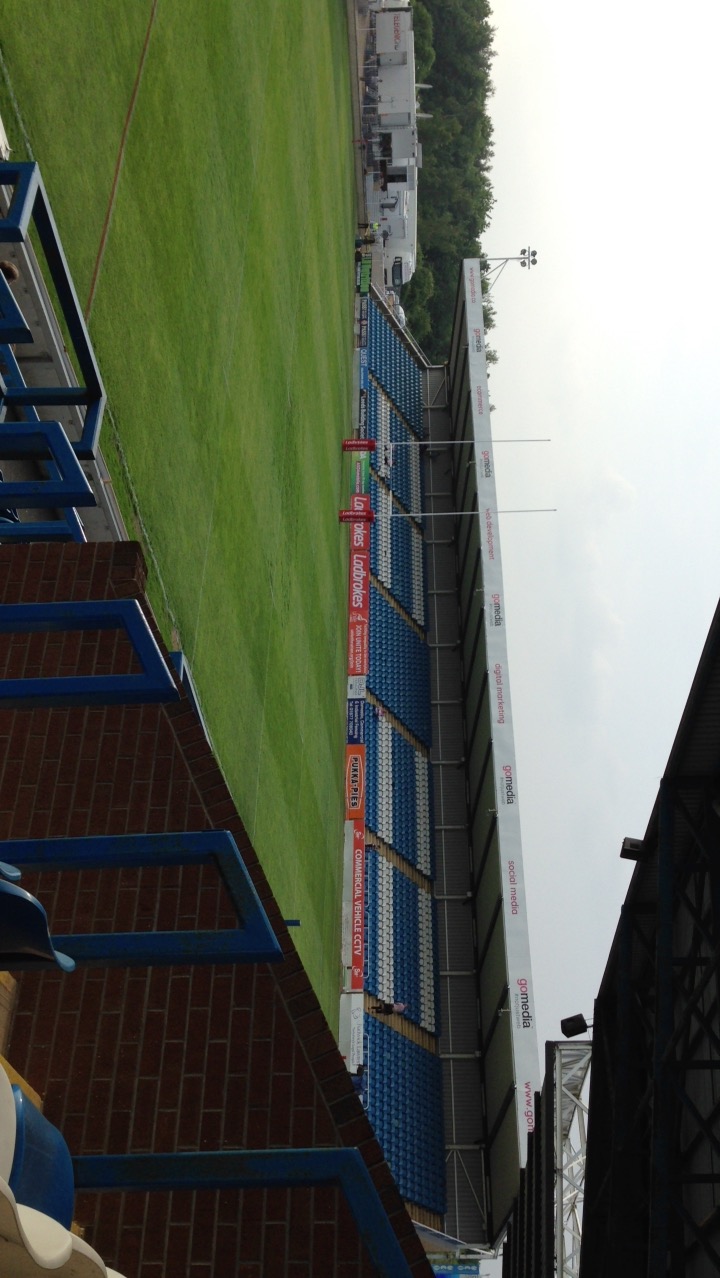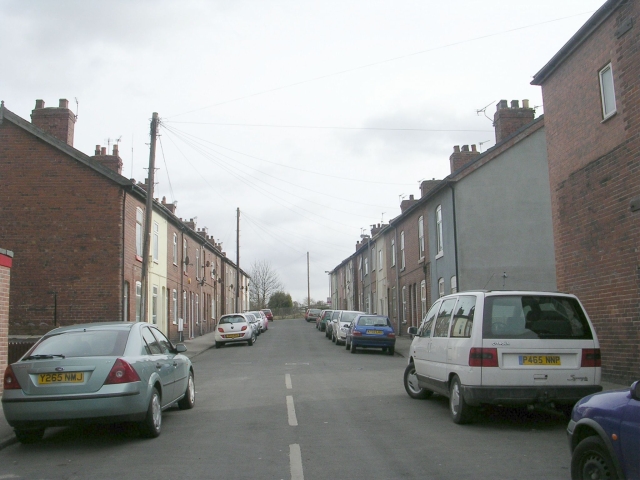|
Post Office Road
Post Office Road (currently known as the Millennium Stadium for sponsorship purposes) is a rugby league ground in Featherstone, near Pontefract, West Yorkshire, England. It is the home of rugby league club Featherstone Rovers. The ground's current capacity is 6,954. History The ground opened in 1904 and has been used by the club since their formation in 1908. The record attendance is 17,000 from a 1957 game against St. Helens. In 2011, fans bought stands from the defunct Scarborough F.C.'s McCain Stadium and erected them at the railway end of the ground, replacing the terracing. Layout North Stand Capacity- (seated) The North Stand or Railway End is the newest part of the ground after originally being terracing it was replaced in 2014 with seated stands which were taken from Scarborough's McCain Stadium. The North-East corner houses the scoreboard. East Stand Capacity- (seated) The Eastern side of the ground has two covered seated stands. The main stand on the halfway ... [...More Info...] [...Related Items...] OR: [Wikipedia] [Google] [Baidu] |
Featherstone
Featherstone is a town and civil parishes in England, civil parish in the City of Wakefield, West Yorkshire, England, two miles south-west of Pontefract. Historic counties of England, Historically part of the West Riding of Yorkshire, in 2011 it had a population of 15,244. Featherstone railway station is on the Pontefract Line. History Despite most population growth taking place around the Industrial Revolution, Featherstone traces its history back much further than this. The Domesday Book (1086) records "In Ferestane [Featherstone] and Prestone [Purston] and Arduwic [Hardwick] and Osele [Nostell], Ligulf had 16 carucates of land for geld, and 6 ploughs may be there." It is thought that a local public house, the Traveller's Rest, can trace its origins to the 17th century whilst the former Jubilee Hotel, a listed building now converted to apartments, once provided a resting place for wealthy Victorians and their horses. Standing stone's just outside the village indicate that th ... [...More Info...] [...Related Items...] OR: [Wikipedia] [Google] [Baidu] |
1995 Rugby League Emerging Nations Tournament
The 1995 Rugby League Emerging Nations World Championship was held alongside the Centenary Rugby League World Cup. Although the competition received little build-up or promotion, the novelty value of the teams taking part encouraged relatively large crowds, and the competition was a success. A crowd of 4,147 was present at Gigg Lane, Bury for the final between the Cook Islands and Ireland.https://www.rugbyleagueproject.org/competitions/emerging-nations-cup-1995/summary.html Squads Cook Islands * Managers – Paul Vaetoru, Ian Wilmott * Coaches – Paul McGreal, Nooroa Tupa Ireland * Manager Mark Casham * Coaches Niel Wood, Terry Flanagan Venues The games were played at various venues in England. The Final was played at Gigg Lane in Bury. Group stage Group A * Cook Islands advanced to the final. ---- ---- Group B * Ireland advanced to the final. ---- ---- Final See also * 2000 Rugby League Emerging Nations Tournament References ... [...More Info...] [...Related Items...] OR: [Wikipedia] [Google] [Baidu] |
Buildings And Structures In The City Of Wakefield
A building, or edifice, is an enclosed structure with a roof and walls standing more or less permanently in one place, such as a house or factory (although there's also portable buildings). Buildings come in a variety of sizes, shapes, and functions, and have been adapted throughout history for a wide number of factors, from building materials available, to weather conditions, land prices, ground conditions, specific uses, prestige, and aesthetic reasons. To better understand the term ''building'' compare the list of nonbuilding structures. Buildings serve several societal needs – primarily as shelter from weather, security, living space, privacy, to store belongings, and to comfortably live and work. A building as a shelter represents a physical division of the human habitat (a place of comfort and safety) and the ''outside'' (a place that at times may be harsh and harmful). Ever since the first cave paintings, buildings have also become objects or canvasses of much artis ... [...More Info...] [...Related Items...] OR: [Wikipedia] [Google] [Baidu] |
Papua New Guinea
Papua New Guinea (abbreviated PNG; , ; tpi, Papua Niugini; ho, Papua Niu Gini), officially the Independent State of Papua New Guinea ( tpi, Independen Stet bilong Papua Niugini; ho, Independen Stet bilong Papua Niu Gini), is a country in Oceania that comprises the eastern half of the island of New Guinea and its offshore islands in Melanesia (a region of the southwestern Pacific Ocean north of Australia). Its capital, located along its southeastern coast, is Port Moresby. The country is the world's third largest island country, with an area of . At the national level, after being ruled by three external powers since 1884, including nearly 60 years of Australian administration starting during World War I, Papua New Guinea established its sovereignty in 1975. It became an independent Commonwealth realm in 1975 with Elizabeth II as its queen. It also became a member of the Commonwealth of Nations in its own right. There are 839 known languages of Papua New Guinea, one of ... [...More Info...] [...Related Items...] OR: [Wikipedia] [Google] [Baidu] |
France National Rugby League Team
The France national rugby league team represent France in international rugby league matches. They are referred to as ''les Chanticleers'' or less commonly as ''les Tricolores''. The team is run under the auspices of the Fédération Française de Rugby à XIII. The French rugby league team first played in 1934 on a tour of England. They have taken part in all World Cups, 16 in total, with the first being held in 1954 in France. They have never won the title but finished runners-up in both 1954 and 1968. These are often considered the glory years of French rugby league as from the 1950s to the 1970s the team were strong and regularly beat Australia, New Zealand and Great Britain. Since those days, ''les Chanticleers'' have not done as well with their nadir occurring at the 1995 World Cup when they failed to win a single match. In 2006, the Perpignan based team Catalans Dragons entered Super League, and have since produced a number of top-class French players. Recent successe ... [...More Info...] [...Related Items...] OR: [Wikipedia] [Google] [Baidu] |
1973 Kangaroo Tour Of Great Britain And France
The 1973 Kangaroo Tour was the thirteenth Kangaroo Tour, and saw the Australian national rugby league team travel to Europe and play nineteen matches against British and French club and representative rugby league teams, in addition to three Test matches against Great Britain and two Tests against the French. It followed the tour of 1967-68 and the next was staged in 1978. The squad's leadership The team was captain-coached by Graeme Langlands making his third Kangaroo Tour. Managers of the team were Albert Bishop and Charlie Gibson with Alf Richards as the team trainer. Touring squad The following players were in the touring squad. , - bgcolor="#CCCCFF" , Player , Club , Position(s) , Tests , Games , Tries , Goals , F/Goals , Points , - , - bgcolor="#FFFFFF" , Arthur Beetson (vc) , Eastern Suburbs Roosters , , align=right , 5 , align=right , 16 , align=right , 3 , align=right , 0 , align=right , 0 , align=right , 9 , - , - bgcolor="#FFFFFF" , Ray ... [...More Info...] [...Related Items...] OR: [Wikipedia] [Google] [Baidu] |
1963–64 Kangaroo Tour Of Great Britain And France
The 1963-64 Kangaroo tour was the eleventh Kangaroo tour, during which the Australian national rugby league team traveled to Europe and played thirty-six matches against British and French club and representative teams. It included three Rugby league#Competitions, Test matches against Great Britain Lions, Great Britain for The Ashes, and three Tests against the France national rugby league team, French. The tour followed the 1959-60 Kangaroo tour of Great Britain and France and was followed by the 1967-68 Kangaroo tour of Great Britain and France. The squad's leadership The Australian team was captain-coached by Western Suburbs Magpies Arthur Summons, though due to injury to Summons the test captaincy fell to St George Dragons, St George Ian Walsh (rugby league), Ian Walsh for The Ashes (rugby league), Ashes series against Great Britain and the first test against France. In the five matches in which neither Summons nor Walsh played, the Kangaroos were captained by Barry Muir (a ... [...More Info...] [...Related Items...] OR: [Wikipedia] [Google] [Baidu] |
New Zealand Kiwis
The New Zealand national rugby league team (Māori language, Māori: Tīma rīki motu Aotearoa) has represented New Zealand in rugby league since 1907. Administered by the New Zealand Rugby League, they are commonly known as the Kiwis, after the Kiwi (bird), native bird of that name. The team's colours are black and white, with the dominant colour being black, and the players perform a haka (sports), haka before every match they play as a challenge to their opponents. The New Zealand Kiwis are currently second in the IRL Men's World Rankings, IRL World Rankings. Since the 1980s, most New Zealand representatives have been based overseas, in the professional National Rugby League and Super League competitions. Before that, players were selected entirely from clubs in domestic New Zealand leagues. A New Zealand side first played in a 1907-08 New Zealand rugby tour, 1907 professional rugby tour which pre-dated the birth of rugby league football in the Southern Hemisphere, making it t ... [...More Info...] [...Related Items...] OR: [Wikipedia] [Google] [Baidu] |
Kangaroo Tour
Kangaroo Tour is the name given to Australian national rugby league team tours of Great Britain and France, tours to New Zealand and the one-off tour to Papua New Guinea (1991). The first Kangaroo Tour was in 1908. Traditionally, Kangaroo Tours took place every four years and involved a three-Test Rugby League Ashes, Ashes series against Great Britain Lions, Great Britain (sometimes called Northern Union or The Lions) and a number of tour matches. The 1911/12 and 1921/22 tours were by the Australasia rugby league team, Australasian Kangaroos as both teams included New Zealand players. Some Kangaroo tours to Great Britain and France also included international friendly matches against Wales national rugby league team, Wales, though these games were not given test match status. The last full Kangaroo Tour was in 1994, although shortened Kangaroo Tours took place in 2001 and again in 2003. Since 1954, the Kangaroos have also made a number of overseas tours for multi-team tournaments ... [...More Info...] [...Related Items...] OR: [Wikipedia] [Google] [Baidu] |
1952–53 Kangaroo Tour Of Great Britain And France The 1952–53 Kangaroo tour was the eighth Kangaroo tour, in which the Australian national rugby league team travelled to Great Britain and France and played forty matches, including the Ashes series of three Test matches against Great Britain and three Test matches against the French. It followed the tour of 1948-49 and the next was staged in 1956-57. The squad's leadership The team was captained by Clive Churchill with Frank Stanmore as vice-captain. Tour co-managers were Doug MacLean and Norm Robinson. In the matches in which ne |







_(2).jpg)